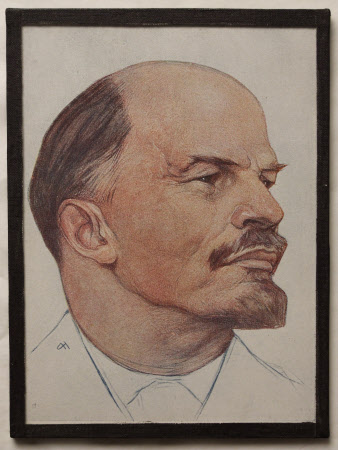Vladimir Lenin
Nikolai Nikileevich Andreev
Category
Art / Prints
Date
circa 1930
Materials
Paper
Measurements
7 x 5.25 ins
Order this imageCollection
Shaw's Corner, Hertfordshire
NT 1274648
Summary
Coloured print, taken from a drawing of Vladimir Lenin (1870-1924) by Nikolai Nikileevich Andreev c.1930. Quarter length, head turned half left. Monogram of artist on jacket collar.
Full description
Coloured print, taken from a drawing of Vladimir Lenin (1870-1924) by Nikolai Nikileevich Andreev c.1930. Quarter length, head turned half left. Monogram of artist on jacket collar at left. Bernard Shaw admired Lenin (head of government of Soviet Russia 1917-1924), besides Joseph Stalin and Felix Dzerzhinskii, owing to the work they had done in constructing the new Soviet society. Both Shaw and Charlotte invested financially in the USSR. Images of all three men were displayed on the dining room mantelpiece at Shaw’s Corner by Shaw at some point after 1930 (probably during the 1940s after Charlotte’s death). In 1920 Shaw described Lenin as “the one really interesting statesman in Europe”. He supported communism, and was sympathetic to Lenin’s vision for Russia. Shaw had initially been a Marxist prior to joining the Fabian Society. In his book The Intelligent Woman’s Guide to Socialism and Capitalism (1928), where he explains how social injustice destroys lives, Shaw declared: “I myself was converted to Socialism by Das Kapital”, and later recalled “I had read Karl Marx fourteen years before Lenin did”. Various works by Marx remain in Shaw’s library in the study. On a visit to Moscow in 1931, Shaw made a speech for radio broadcast where he identified with the Soviet leader: “I myself am like Lenin. I am a revolutionist. I think I was born a revolutionist”. (Shaw, “Lenin”, 27 July 1931, in Dan Laurence, ed., Bernard Shaw: Platform and Pulpit, 216). Shaw went to Lenin’s mausoleum in Red Square, and met his widow. He collected numerous publicity photographs of Lenin during this tour, including some of the Soviet leader lying in state in 1924. Lenin however had viewed Shaw’s Fabian socialism as misguided, famously referring to him as “a good man fallen amongst Fabians”. (Lenin, in A. Ransome, Six Weeks in Russia in 1919, p.78). Lenin’s portrait is on the mantelpiece in the dining-room, placed next to those of Stalin and Dzerzhinskii. Adjacent images of Henrik Ibsen and Mahatma Gandhi represent a more humanitarian outlook that was staged by Shaw to deliberately challenge the Soviet presence.(Alice McEwan, 2020)
Provenance
The Shaw Collection. The house and contents were bequeathed to the National Trust by George Bernard Shaw in 1950, together with Shaw's photographic archive.
Makers and roles
Nikolai Nikileevich Andreev, artist

